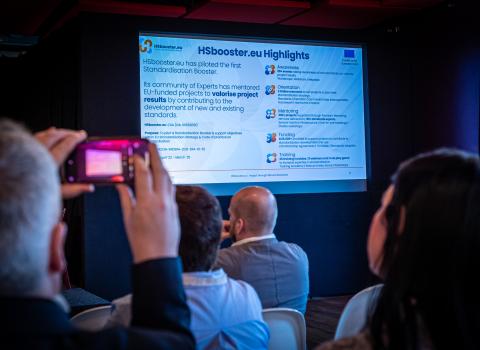The SME instrument launched last year has attracted interest from across Europe, but overall the quality of applications is low, according to the Jean-David Malo, head of SMEs, Financial instruments and State aid unit at DG RTD. “There is a high level of demand but the success rates are very low and range from 6 to 10 per cent in phases one and two,” he said.
However, projects which do meet the quality threshold have a 50 per cent chance of success. And the SME Instrument is gathering applications from a broad range of fields, ranging from ICT and manufacturing, to nanotechnologies and clinical research on biomarkers and diagnostic medical devices.
Malo was presenting the first data on success rates at the Science|Business Horizon 2020 conference. “The SME Instrument is one of the main novelties under Horizon 2020 and is dedicated to the development of innovative SMEs across Europe,” he said.
SMEs are eligible for funding through three phases of product development, from research through to commercialisation. The structure is intended to provide support across the innovation cycle, but companies can apply for funding at any phase.
The first phase, proof of concept, assesses the technical feasibility and commercial potential of the project.
In the second phase, funding is available for projects which already have a business plan. The activities funded at this stage are preparing the project for market and can range from prototyping to design, and from performance verification to the development of pilot lines.
The third phase facilitates the commercialisation, through support to further advance investment readiness, linking with private investors and customers through brokerage activities, or assistance in applying for further EU risk finance.
Success rates
At the conference, Malo showed the audience the evaluation results for the first two phases of the instrument. “The demand is very high but the overall quality of the projects is very low,” said Malo. However, for projects that meet the quality criteria the outlook is good. “More than 50 per cent of the projects above the threshold are funded,” said Malo.
“There are SMEs submitting proposals directly in the second phase,” said Malo. “But very few projects in the first phase moved up to the second phase.”
There are significant differences in the level of submission between the cut-off dates, but Malo says the explanation is very simple: “SMEs don’t have the right to resubmit a proposal [until] after receiving the evaluation of a previous proposal.”
Table 1: The SME Instrument under H2020: Submission stats, evaluation results and funding rates; Courtesy of Jean-David Malo

For the first phase, 592 out of 6,973 applicants were successful. For the second phase 134 projects were successful out of a total of 1,209.
The Instrument is gathering applications from a broad range of fields. The 134 successful projects in the second phase cover fields ranging from ICT and manufacturing, to nanotechnologies and clinical research on biomarkers and diagnostic medical devices.
Table 2: The SME Instrument under H2020: Phase 2 Call Topics
Access to finance
Malo believes the EU, “should support and finance innovation and SMEs by all means, be it debt financing, equity or quasi-equity financing.”
Newly rebranded instruments from the European Investment Bank are designed to do specifically that. The InnovFin SME Guarantee covers up to 50 per cent of the losses resulting from financing innovative SMEs. The EIB also provide two products for innovative mid-caps: the mid-cap guarantee and the mid-cap growth finance.
“The demand for these instruments is enormous,” said Malo. Looking at the pipeline of projects the Commission has received to date from the EIB and the European Investment Fund, “We will be able to achieve up to 30 per cent of our objective already at the end of 2015,” said Malo.
Despite this, it seems the awareness of these instruments is not widespread. “I heard we need to improve the way we communicate about these mechanisms,” said Malo. “We need to ensure that the information is better disseminated at the appropriate levels and use the national contact points to disseminate information.”
For the future, Malo believes the Commission, “Has to think more globally and to prepare grants for very ambitious and politically-oriented projects, such as how to finance research infrastructures in Europe.”
In order to achieve this, “We have signed a technical assistance agreement with the EIB’s InnovFin Advisory which is providing very good results,” Malo said.
So far, “We are learning by doing because we have created a lot of expectations in the market whilst our message was not very clear,” concluded Malo.





 A unique international forum for public research organisations and companies to connect their external engagement with strategic interests around their R&D system.
A unique international forum for public research organisations and companies to connect their external engagement with strategic interests around their R&D system.